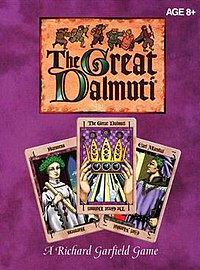The Great Dalmuti

Retail packaging.
|
|
| Origin | United States |
|---|---|
| Type | Trick-taking |
| Players | 3+ (5-8 best) |
| Skills required | Memory, Tactics, Communication |
| Age range | 8+ |
| Cards | 80 (2 Jesters) |
| Deck | Custom |
| Play | Clockwise |
| Card rank (highest to lowest) | Jester (wild), Dalmuti, Archbishop, Earl Marshal, Baroness, Abbess, etc... |
| Playing time | 10 min. |
| Random chance | Medium |
| Related games | |
| President, Dai Hin Min | |
The Great Dalmuti is a card game designed by Richard Garfield, illustrated by Margaret Organ-Kean, and published in 1995 by Wizards of the Coast. It is a variant of the public domain game president, dating back to late Middle-Ages. The game was Awarded Best New Mind Game 1995 by Mensa, and was in Games Magazine's 1996 Games 100. The game fell out of print, but was re-released in 2005.
Though based on a public domain game, the Dalmuti deck is non-standard. There is a number of each rank of cards (1 through 12) equal to that rank, so twelve 12s, eleven 11s, and so on. There are also two Jesters, which are wild cards.
The game plays best with 5 to 8 players, though more is possible. The goal is to get rid of your cards by playing grouping of the same rank, such as three 4s. The higher the rank of the card, the worse it is, with the Jester ranked as a 13 (unless played as a wildcard). You can only play a lower rank of the same number of cards as the previous player or you must pass.
The rank of the players is also important. The player in the lead after a particular hand is the "greater dalmuti," and the player to his or her left is the "lesser dalmuti." The player to the greater dalmuti's right is the "greater peon", and the player to that player's right is the "lesser peon." At "taxation" time before each round, the greater dalmuti forces an exchange of two cards from his hand with the greater peon two best cards (lowest numbered cards, always counting the Jester as 13 for this purpose), and the lesser dalmuti swaps one card with the lesser peon in a like manner. These ranks are also enforced for other aspects, such as clearing the cards after a round and sometimes getting drinks or other social aspects. The rank can change every hand, so being particularly mean to one's lessers can come back to haunt a player.
If a player gets both jester cards, he or she may call for an end to taxation (called a "revolution"). A game variant is that a revolution can be called by either peon with a single jester. If the greater peon has both jesters, he/she may call a "greater revolution" which results in all seats being swapped (so the greater peon becomes the greater dalmuti, the Lesser Peon becomes the lesser dalmuti, etc.).
Each card in Dalmuti has a medieval name. Each rank is represented by an equal number of cards to its rank, except for the two Jesters.
...
Wikipedia
